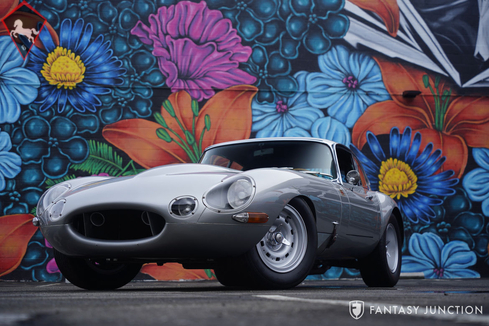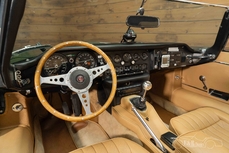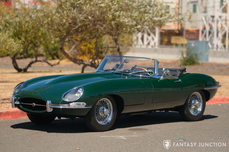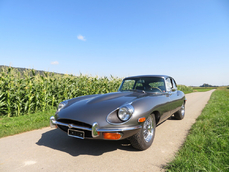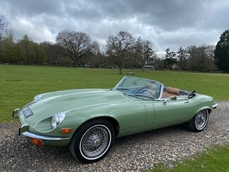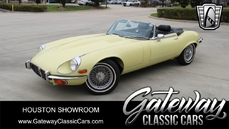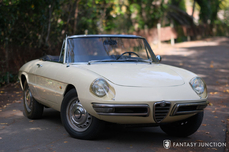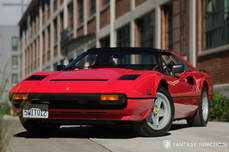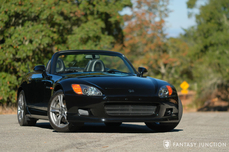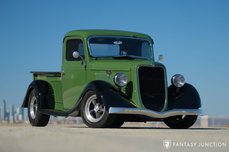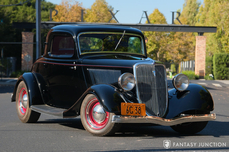Jaguar E-type 4.7L straight 6-cylinder 1963
Allgemeine Beschreibung :
1963 Jaguar XKE Eagle-Engineered Lightweight Conversion 4.7
s/n 888326 engine no. 8L99151H
Silver with Green Leather Interior
When Jaguar unveiled the XKE at the 1961 Geneva Motor Show, everything changed in the world of sports cars. Breathtaking design, unrivaled performance, and racing lineage made the XKE an immediate sensation. Beautiful and popular, the XKE proved even more spectacular, setting records, and posting victories all over the world. In the same tradition that Jaguar built the original lightweight race cars, recognized experts in period correct XKE craftsmanship and performance enhancements, together with the commissioning owner, spared no expense creating this superb tribute to Jaguars’ legendary XKE Lightweight Coupe.
This car was originally commissioned and built to an incredibly high specification for world renowned collector, Paul Michaels, of Hexagon fame. Developed by recognized experts in period correct XKE craftsmanship and performance enhancements, together with the commissioning owner, the team spared no expense creating this superb tribute to Jaguars’ legendary XKE Lightweight Coupe. Beginning with a sound road car, this Series 1 coupe was completely disassembled and reconfigured to full Lightweight standards including extensive modifications to the engine, body, suspension, electronic systems, cooling system, brakes, and interior. The hand-crafted car was completed in the early 2000s to impeccable standards by top fabrication specialists, following closely to factory specifications while using authentic parts. Following final modification, enhancements, and restoration works by Eagle for performance and safety resulted in this beautifully constructed Eagle-Engineered Lightweight Conversion.
As might be expected, the construction history surrounding the build is both technically impressive and artfully engaging. Beginning with the body, the structural steel core was retained while a set of custom RS hand-formed alloy body panels (alloy hood, doors, rear arches, and trunk lid) were fitted to the steel structure. A set of lightweight peg-drive Dunlop-type magnesium wheels were fitted, and the engine was comprehensively built by Rob Beere, upgraded to 4.7 Liter specifications. Engine improvements included a big valve cylinder head with Sport cams, Sport lightened and balanced engine components, gas flowed head with matched ports, a gated anti-surge pump, and big-bore tubular exhaust manifolds. The engine was mounted using specially fabricated Sport mounts, a harmonic crankshaft damper, electronic ignition with performance plug leads, and a modern performance electric fuel pump. Cooling was improved using a modern cooling fan, lightweight alloy radiator, brass water tank, and Kevlar reinforced cooling hoses.
The 4.7 Liter engine was dyno-tuned returning 307 hp at the rear wheels with more than 300 ft/pounds of torque from 3,200 to 5,200 rpm. An all synchro 5-speed Getrag gearbox was installed along with a 3.07:1 rear end. Brakes and suspension were upgraded as well with a high-powered stainless-steel shielded brake booster, AP front alloy brake calipers with 315mm ventilated rotors with adjustable brake bias. GT torsion bars and springs, GT sway bars and bushings, polyurethane radius arm and arb bushings, Eagle Sport radius arm conversion, and billet aluminum steering rack mounts were also installed. Additional features included Spax adjustable shocks, high output charging system with 75-amp alternator, a lightweight geared starter motor, and halogen headlights. The resultant performance enhancements and build exceeded $100,000.00.
Upon completion, Paul Michaels enjoyed the car, successfully participating in a variety of European tours, covering some 4,687 kms (2,912 miles). Around this time, Paul was fortunate to purchase 86 PJ, an exceptional original and genuine factory lightweight, one of just twelve originally built. Michaels then commissioned Eagle, world renowned E-type experts, to carry out a comprehensive sympathetic restoration to the original lightweight and further engaged Eagle to sell this Lightweight Coupe.
Eagle, most well known for their ‘Eagle E-Types’, including their own Lightweight inspired ‘Special Editions’, also offer carefully selected previously restored E-types, which can be crafted with unique and exclusive access to a range of Eagle engineering features as well as full Eagle commissions. As is the case with this offering, these cars, such as the example offered here, are uniquely branded as the "Eagle Engineered E-type”.
With Michaels’ Eagle presented on exclusive offer, Eagle soon found a new owner in California. The new owner then engaged Eagle to apply their bespoke rear suspension ‘Sport specification’ upgrades to the car and to rebuild the suspension unit at the same time.
Concurrent with other upgrades already fitted, the outcome mirrored the specifications of an "Eagle GT", this work was completed on 25 Nov 2004 and numbered as “Eagle-Engineered E-Type”, assigned number 41, and an Eagle GT badge was added to the center console. At this time, a dozen or so of the full, totally in house restored Eagle E-types had been completed and delivered. The Eagle Engineered option was introduced due to lead times for a completed commission running into several years.
The car was brought to California, titled, and registered as a 1963 Jaguar for the new owner, who enjoyed the car for two years, driving it frequently. An avid vintage performance car enthusiast, the northern California owner engaged professional Jaguar performance specialists to service and upgrade the car as needed including regular fluids and interval services, including fluid exchanges, brake fluid flush, and seal replacement, a new electronic ignition kit, SU carburetor tuning, ammeter repair, water pump rebuild, various gaskets replaced, cooling system serviced, and various electrical wiring improved. In 2006 The car was then sold through Fantasy Junction to the third post-construction owner, who retained it for 14 years, enjoying it sparingly.
In 2022, Fantasy Junction offered the car for sale again. At that time, 4,100 miles were indicated. The second post-build owner then repurchased the car making him both the second and fourth owner of record since the build. Under his ownership in November 2022 with 4,550 miles indicated, experts at American Classics and Performance, Cotati, CA performed approximately $29,000.00 worth of detailed services. Beginning the process, the top end of the engine was disassembled, and the head removed for a professional valve job, during reassembly the cam gears and upper chain tensioner were reinstalled with adjustments made, and the oil and filter changed. A new set of spark plugs was installed, and the engine was cleaned and prepped along with various items refinished as needed before complete reassembly. Additional work included replacing all fuel hoses, carburetor service including new floats, matched needles, tuning and synchronizing the carburetors, installing air/fuel meter, new screens for the velocity stacks, a new brake light switch, new battery, and new cooling hoses. The car also received a new fuel tank with new fuel hoses, the clutch slave and master cylinder were rebuilt, a new set of Avon tires (invoiced at separate cost) were balanced and mounted, and all four wheels were powder coated for increased durability.
Today the car presents as a spectacular example combining authentic aspects in tribute to the original Lightweight themes with impressive contemporary upgrades and excellent finishes throughout. The paint was done to a very high standard, with excellent gloss and consistent coverage, now showing just minor evidence of enjoyable use. Panel fit and gaps are excellent in all aspects of body construction including the muscular alloy rear fenders, smooth alloy nose, and alloy doors. With the front and rear bumpers removed, the body design is even more elegant and purposeful as a competition statement. The lighting, lenses, and windshield are in excellent condition including the leather bonnet latches, one of many handsome vintage touches. The recently refinished magnesium wheels and new Avon tires add to the authentic stance and presence. The exposed rivet construction, outside alloy filler cap, and smoothed front/rear finishes all contribute to the competition presence of this Eagle-Engineered Lightweight Conversion.
The interior of the car is as carefully thought out and as nicely detailed as the exterior. Opening the lightweight aluminum doors, the competition inspired interior is comfortable, not sparse, conveying the perfect balance of racing and road-going excellence. The seats are wrapped in supple green leather accompanied by 5-point seat harnesses, a leather wrapped central tunnel, black low-pile carpeting, and a stock XKE dashboard trimmed with green and black accents completes the interior finishes. Modest use is evident in the interior mostly to the driver’s side seat bolster which shows some wear from entry and exit. The wood steering wheel is slightly larger in diameter to allow improved rigidity under more spirited driving. The 5-speed Getrag gearbox is topped with an alloy shift knob and traditionally fitted with a matching green leather boot. A roll bar is installed, green headliner affixed to the inner roof panel and rear hatch, a modern fire system is in place, and a matching Dunlop type spare tire is located under the rear hatch panel. A custom-fabricated alloy fuel tank is in place, flanking the spare tire. The interior exhibits a nice blend of vintage competition Jaguars, with just enough comfort to enjoy driving without the harshness of typical competition cars.
Lifting the lightweight aluminum hood, the engine and engine bay reveals the 4.7 Liter engine with details prepared in homage to the original. Though recently freshened with a valve job and other engine refinements, the engine retains a unified patina consistent with competition cars including heat toned header exhaust and buff aluminum finishes. Here too upgraded features have been thoughtfully installed for reliable use. Conceived and built with combined road and rally/touring use in mind, the engine systems are all easily accessed and modern upgrades including electronic ignition, electric fuel pump, modern alternator, and cooling enhancements (alloy radiator and electric fan) have proven to be appropriately specified. Further features include recently tuned triple SU carburetors, traditional Lucas Engineering branded features, new fuel and cooling hoses, and a new battery. The underside of the car is very clean, nicely sorted, and appropriately finished reflective of the miles and use reported since the build was completed.
The car starts and drives very well. The 4.7 Liter engine is very strong with very quick throttle response and yet still usable for general driving, tours, or light duty track days. The 5-speed gearbox is a full synchro Getrag unit which operates smoothly. The brakes and steering are very well dialed in and the 3.07:1 rear end is suitable for highway use. In all, the driving experience is both invigorating and delightful, feeling very much like a competition car, in looks and heritage, but delivering a satisfying road manner that a capable driver can enjoy with confidence. The car is accompanied by numerous copies of build documentation, copies of invoices for recent services, Eagle-Engineering specifications sheets, dyno sheet, magazine articles, a series of photographs showing the build including body work and engine build, a car cover, and a set of tools in a tool roll.
For anyone seeking an exciting competition inspired car with vintage presence, this Jaguar XKE Eagle-Engineered Lightweight Conversion offers a unique design coupled with wonderful driving manners and superb performance that is sure to please any Jaguar performance enthusiast.
1963 Jaguar E-type 4.7L straight 6-cylinder is listed zu verkaufen on ClassicDigest in California by Fantasy Junction for $289500.
Fakten der Auto
Karosserietyp : Auto Marke : Jaguar Modell : E-type Ausführung : 4.7L straight 6-cylinder Hubraum : 4.7 Modelljahr : 1963 Lage : Emeryville Fahrzeug Anmeldung : Normal
289500 $
Angaben Zum Verkäufer
Fantasy Junction
Fantasy Junction
+1 510 653 7555
Fantasy Junction
+1 510 653 7555
People who viewed this Jaguar E-type also viewed similar Jaguar listed at ClassicDigest
Other cars listed for sale by this dealer
über Jaguar
Ah, die Geschichte von Jaguar, von seinen Anfängen als SS Cars Ltd. bis hin zum Höhepunkt mit dem D-Typ und der Straßenversion des ikonischen E-Typs. An dieser Erzählung haftet etwas zutiefst Britisches, und ich werde sie erzählen, wie es ein britischer Journalist tun würde.Die Anfänge:
Unsere Reise in die Welt von Jaguar beginnt in den 1930er Jahren, als ein Unternehmen namens SS Cars Ltd. auftauchte. Trotz des unglücklichen Zufalls ihrer Initialen, die mit den aufkommenden politischen Spannungen in Europa zusammenfielen, begannen sie, stilvolle und leistungsorientierte Autos herzustellen. Der SS 100, der 1936 eingeführt wurde, war ein Symbol für Eleganz und Geschwindigkeit und legte den Grundstein für das, was Jaguar werden sollte.
Die Geburt von Jaguar:
Als der Schatten des Zweiten Weltkriegs näher rückte, entschied sich SS Cars Ltd. klugerweise, sich von den SS-Initialen zu distanzieren. So wurden sie 1945 offiziell zu Jaguar Cars Ltd., ein Name, der bald für britischen Luxus und Leistung stehen würde.
Die XK-Serie:
Die Nachkriegszeit von Jaguar brachte uns den XK 120, eine wahre Sensation im Jahr 1948. Mit seinem schlanken Design und einem leistungsstarken 3,4-Liter-Sechszylindermotor wurde er zum schnellsten Serienauto der Welt. Der XK 120 war die Blaupause für das, was kommen würde - Jaguars, die Stil mit Geschwindigkeit auf einzigartig britische Weise verbanden.
Die Dominanz des D-Typs:
Dann kam der D-Typ, eine wahre Rennlegende. 1954 eingeführt, gewann er in den 1950er Jahren dreimal Le Mans und zeigte die technische Kompetenz von Jaguar. Mit seiner innovativen Monocoque-Konstruktion und der ikonischen Finne hinten war der D-Typ der Höhepunkt von Jaguars Motorsporterfolgen.
Das Auftauchen des E-Typs:
Aber der wahre Wendepunkt kam 1961 mit der Einführung des E-Typs, oft von Enzo Ferrari als "das schönste Auto, das je gebaut wurde" bezeichnet. Seine lange Motorhaube, die geschwungene Karosserie und ein 3,8-Liter-Motor, der atemberaubende Leistung lieferte, machten ihn sofort zu einem Klassiker. Der E-Typ war nicht nur ein Auto; er war ein Kunstwerk auf Rädern und konnte auf der Straße 150 Meilen pro Stunde erreichen.
Straßen- und Rennsporterfolge:
Die Schönheit des E-Typs wurde durch seine Leistung auf der Rennstrecke unterstrichen. Die leichten E-Typen waren bei verschiedenen Rennveranstaltungen besonders erfolgreich und festigten den Ruf von Jaguar als eine Kraft, mit der man im Motorsport rechnen musste.
Das Zeitalter der Raffinesse:
Je tiefer wir in die Geschichte von Jaguar eintauchen, desto mehr erkennen wir, dass die 1950er und 1960er Jahre ein Zeitalter der Raffinesse und Expansion waren. Neben dem großartigen D-Typ und dem ikonischen Aufstieg des E-Typs führte Jaguar Modelle ein, die seinen Ruf für Luxus und Leistung weiter festigten.
Der MK2:
Ende der 1950er Jahre stellte Jaguar den MK2 vor, eine Sportlimousine, die Eleganz mit Leistung vereinte. Diese elegante viertürige Limousine war sowohl bei Bankräubern als auch bei der Polizei aufgrund ihrer außergewöhnlichen Geschwindigkeit und Handhabung beliebt. Der MK2 war ein Symbol für Jaguars Fähigkeit, Raffinesse mit Leistung zu verbinden und hatte auch eine erfolgreiche Rennkarriere.
Der XJ6:
Springen wir ins Jahr 1968, als Jaguar ein Auto auf den Markt brachte, das Jahrzehnte lang Luxuslimousinen definieren würde - den XJ6. Es war ein Meisterwerk der Ingenieurkunst und des Designs, mit einem sanften Reihensechszylindermotor, unabhängiger Hinterachse und einem geräumigen, wunderschön ausgestatteten Innenraum. Der XJ6 war ein Symbol britischer Eleganz und bot eine so sanfte Fahrt, dass es schien, als würde er förmlich über die Straße gleiten. Er wurde zum Flaggschiffmodell für Jaguar und setzte den Maßstab für Luxuslimousinen und zeigte ein Maß an Raffinesse, das die Konkurrenz staunen ließ.
Die Verschmelzung von Klassik und Moderne:
Während der MK2 und der XJ6 die Evolution der Limousinen von Jaguar repräsentierten, bewahrten sie das Engagement der Marke für Leistung und Luxus. Diese Autos gehörten nicht nur auf die Rennstrecke; sie fühlten sich genauso wohl auf den Prachtstraßen wie auf einer entspannten Fahrt durch die englische Landschaft.
Die Herausforderungen des Wandels:
Dennoch sah sich Jaguar mit dem Eintritt der 1970er Jahre, wie viele britische Automobilhersteller, finanziellen Herausforderungen und Veränderungen in der Eigentümerschaft gegenüber. Die Ära von British Leyland brachte sowohl Chancen als auch Schwierigkeiten mit sich, während die Marke durch verschiedene Fusionen und Übergänge navigierte.
Das Erbe des MK2 und des XJ6, zusammen mit dem D-Typ und dem E-Typ, definiert Jaguar weiterhin als einen Hersteller, der zeitlose Eleganz mit einer Leistungsstärke vereint. Diese klassischen Modelle, ob sie über kurvige Straßen gefahren oder als Sammlerschätze geparkt werden, dienen als Zeugnis für die anhaltende Präsenz von Jaguar in der Welt der automobilen Exzellenz.
Die Jaguar-Geschichte, von ihren Anfängen als SS Cars Ltd. bis zur Schaffung von Automobilikonen wie dem E-Typ, dem MK2 und dem XJ6, ist eine Reise, die das Wesen des britischen Automobilbaus widerspiegelt - eine Mischung aus Luxus, Leistung und Stil, die nach wie vor Enthusiasten und Kenner gleichermaßen fasziniert.
